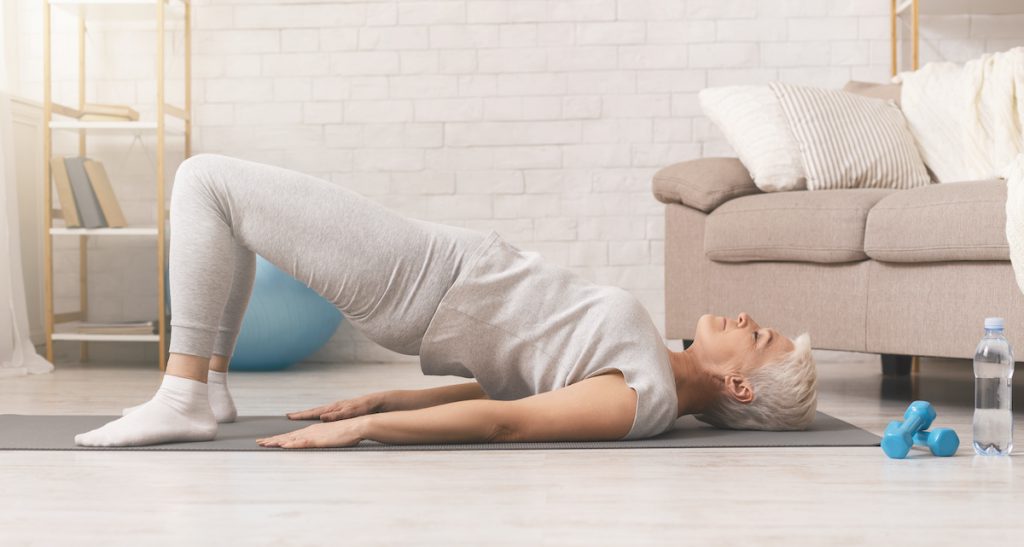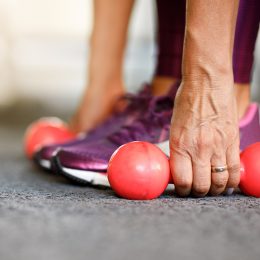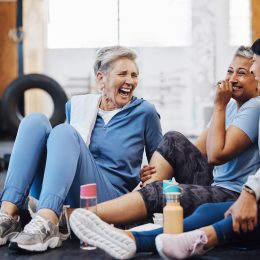Building Core Strength: The SilverSneakers Guide
Learn why core strength is essential for your mobility and your overall health, plus the simple moves that can make you stronger.
 When you hear the term “strong core,” you might picture belly-baring shirts, six-pack abs, and hours of time sweating over sit-ups at the gym. But all that intense work isn’t necessary: You can build a solid core without any gym time or sit-ups—or wishing for that washboard look that won’t realistically ever happen.
When you hear the term “strong core,” you might picture belly-baring shirts, six-pack abs, and hours of time sweating over sit-ups at the gym. But all that intense work isn’t necessary: You can build a solid core without any gym time or sit-ups—or wishing for that washboard look that won’t realistically ever happen.
Your body’s core encompasses far more than your stomach muscles, and it plays an essential role in your day-to-day living. Focusing on building strength in that area can reap many health rewards. Here’s what you need to know.
Get and stay fit with SilverSneakers! Choose from dozens of different Community classes, visit a participating fitness location, or join one of 20+ SilverSneakers LIVE online classes. Check your eligibility here.
What are your core muscles?
Your “core” is the group of muscles around the trunk of your body, which includes the abdominal muscles, hips, and lower back. These muscles support the spine and pelvis, and they aid any type of movement that uses the middle of your body, such as bending, lifting, twisting, and walking.
Think of the core as a muscular box—or a tight-fitting girdle—that runs from your diaphragm to your pelvic floor. There are a lot of muscles between these two areas:
- Obliques, which are located along the sides of your abdominal muscles
- Transversus abdominis, which is a deep abdominal muscle that wraps around your body from front to back
- Multifidus, the muscles along each side of your spinal column that stabilize your lower back
- Rectus abdominis, also known as the “six pack” of the abdominal area
- Quadratus lumborum, the deepest muscle of the abdominal wall that’s often involved in lower back pain
- Multiple hip muscles that support the pelvis and hip joints
When your core is engaged or “firing,” as a fitness trainer might say, there are over a dozen muscles working together to help keep your body stabilized.
Why is core strength important?
Strength in this area matters a lot, but according to the Mayo Clinic, core exercises are often neglected in fitness programs. You should seek out activities that engage the muscles in this area, which will provide major life-enhancing benefits:
- Improved balance and stability
- Better athletic performance, whether that means a faster pace on morning walks, boosting your pickleball game, or having more endurance in a SilverSneakers class
- More ease in everyday activities, even minor ones like reaching for something on a high shelf or tying your shoes
- Lower risk of back, neck, and shoulder pain
- Greater energy and less fatigue
As you can see, core strength is crucial for everyday living. Even movement that doesn’t seem to be related to your core muscles—like walking, climbing stairs, or carrying a full laundry basket—all depend on them. That means the stronger you make your core, the more effectively you’ll move.
What problems can weak core muscles cause?
You can have excess belly fat and a strong core, but that’s often not the case. Excess belly fat can harm your health, increasing the risk of chronic diseases such as type 2 diabetes and some types of cancer.
According to the American Heart Association (AHA), belly fat can increase heart disease risk, particularly for women. Even if you’re considered a normal weight on the body mass index (BMI) scale, a larger waist circumference can significantly increase your risk for cardiovascular problems.
Research also suggests there’s a strong link between weakness in the core muscles and poorer physical function. Weak core muscles are associated with these issues:
- Back and shoulder pain
- Reduced mobility
- A greater risk of falling
- Poor posture, which can lead to headaches and neck pain
And if that weren’t enough, there can be a ripple effect that goes beyond those problems. You might also have trouble sleeping, lower energy levels, weight gain, and even symptoms of depression and anxiety—both of which are strongly linked to lower-back pain.
How do I know if I have weak core muscles?
Like any muscle in the body, core muscles will weaken when they’re not used. So if you’re mostly sedentary, your core may not be very strong. But even if you are physically active, it can be hard to tell if your core needs more attention.
Here are some signs you should be looking for:
- Chronic lower-back pain
- Trouble getting out of a chair or bed without relying on upper body strength
- Slouched posture while sitting or standing
- Difficulty standing for long periods of time
- Poor balance or a frequent need to hold on to walls, chairs, or other objects when walking
- Digestion issues or difficulty taking deep breaths, both of which can be related to poor posture
Nearly everyone can benefit from better core strength. If you have gastrointestinal troubles, such as irritable bowel syndrome, talk to your doctor before starting a core-centric exercise routine. You may be referred to a physical therapist who can help you safely strengthen this area without making your condition worse.
What exercises can help build my core?
Any activity that works your abdominal and back muscles in a coordinated way counts as core strengthening, according to the Mayo Clinic. That might be using free weights in a strength-training routine or carrying groceries in from your car.
SilverSneakers fitness classes incorporate core-strengthening exercises that are good for all fitness levels. Be sure to get your doctor’s OK before beginning any new exercise program.
If you’re new to exercise or bouncing back from an injury, SilverSneakers Classic features easy-to-follow exercises to build head-to-toe strength and endurance. It’s offered both in-person at participating fitness locations or online through SilverSneakers LIVE.
For variety, try SilverSneakers Yoga (both in-person and online), Cardio & Strength (Express), or Seated Strength (Express) — the latter two are offered online through SilverSneakers LIVE.
Press play to try an 8-Minute Core Strength Workout led by SilverSneakers trainer Andi Kwapien:
Other home workouts to try:
- 7 Standing Core Exercises for Seniors
- 10 Minute Strong-and-Stable Core Workout
- Make Your Core Work for Everyday Life
- Best Lower-Abs Exercises for Older Adults
- Strong to the Core Challenge: 8 Days of Showing Your Midsection Some TLC
It doesn’t take hours at the gym to get a great workout. In fact, many of these sequences only take 10 to 15 minutes, and they make an excellent addition to other fitness activities you might already be doing.
Can other lifestyle changes improve my core too?
Absolutely, yes. Exercise is one way to whittle your middle, but several other healthy habits can do the trick too. The SilverSneakers exercises listed above target the core muscles, but losing belly fat—which puts less strain on your lower back—can be accomplished in other ways:
Eat enough protein. Research suggests that people begin to lose muscle mass slowly after age 30, but that process speeds up once you hit 60. That muscle is usually replaced by fat.
The amino acids in protein help the body repair and maintain muscle tissue. Eating about 75 to 90 grams of protein a day—include it in all your meals—helps you rebuild the muscle tone you’ve lost.
Subscribe to our newsletter
It's quick and easy. You could be one of the 13 million people who are eligible.
Already a member? Click to discover our 15,000+ participating locations.
Follow Us
Recommended reading: Protein and Older Adults: How Much Do I Need Every Day?
Lower your stress levels. Chronic stress can lead to unwanted belly fat, mainly because the body releases the hormone cortisol when you’re feeling overwhelmed.
When cortisol is elevated for too long, the body will start to store energy (also known as fat) in the abdominal area, to help you respond to potential threats. But if those perceived dangers never arrive—you’re probably not being chased by a bear, after all—you’re just collecting more fat in that part of the body.
Meditation, yoga, and connecting with others can help lighten your mental load.
Focus on getting quality sleep. Cortisol can also stay elevated if you have sleep issues like insomnia. That could mean having trouble falling asleep or staying asleep.
When you’re tired—and this is true for feeling stressed too—it’s harder to keep yourself from reaching for unhealthy, fatty comfort foods. Aim for seven to nine hours a night. Talk to a doctor if you never get anywhere near that much.
Making an effort to build your core muscles can boost your overall well-being and improve your quality of life. Shedding unwanted pounds and improving your balance, mobility, strength all leads to greater confidence too.
You may never get that six-pack look, but who cares? You’ll achieve something even better: Easier movement for everything you do.
See Our Sources:
Core muscles: Physiopedia. (2022) Core Muscles
Importance of core strength: Mayo Clinic. (2021) Core exercises: Why you should strengthen your core muscles
Belly fat: American Heart Association/Circulation. (2008) Abdominal Obesity and the Risk of All-Cause, Cardiovascular, and Cancer Mortality
Weak core muscles: BMC Musculoskeletal Disorders. (2019) Abdominal trunk muscle weakness and its association with chronic low back pain and risk of falling in older women
Back pain/ripple effect: Mayo Clinic. (2021) Back pain
Signs of weak core: Harvard Medical School. (2021) 3 surprising risks of poor posture and Samaritan Health Services. (2021) Stay Fit & Flexible With a Strong Core
Muscle mass loss: Journal of Post-Acute and Long-Term Care Medicine. (2011) Sarcopenia
Protein: National Library of Medicine. (2016) Protein Intake and Muscle Function in Older Adults
Stress and belly fat: The American Institute of Stress. (2022) Stress, Cortisol, and Abdominal Fat
Sleep: Mayo Clinic. (2022) Effects of Experimental Sleep Restriction on Energy Intake, Energy Expenditure, and Visceral Obesity
Take Your Favorite SilverSneakers Classes Online!
SilverSneakers members can access live fitness classes and wellness workshops through SilverSneakers LIVE. See the latest schedule and RSVP for classes here.
Not a member? If you have a Medicare Plan, it may include SilverSneakers—at no additional cost. Check your eligibility instantly here.
Not eligible for SilverSneakers? You can still get 200+ free SilverSneakers On-Demand videos and stay in touch with us by creating your online account.





